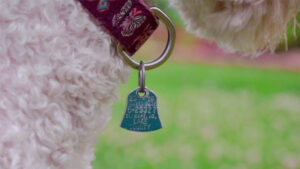rving with pets - paws on board
Protect your Pet with Pet IDs - Dr Fitz Provides Options
“Paws on Board” is brought to you by Jones Natural Chews, American sourced and made in America.
Welcome to “RVing Today’s” “Paws On Board,” I’m Dr. Fitz, and this is Sully. Today we’re going to be discussing identification, specifically what types of ID are available for dogs and how they can help to reunite pets with their owners. I’ve said this before on “Paws On Board,” and I’ll say it again. Every dog should have some form of ID on them. This is invaluable in the event that your dog slips their harness or collar or decides to wander away from the campsite. Good identification increases the odds that you will be reunited with your dog.
 One of the most common forms of identification is a dog tag. These can be easily printed at pet stores and attached to your dog’s harness or collar. These tags should at minimum include your name and phone number, bonus points if you have your address as well. This form of ID is cheap, easy to attach, and you can get creative with it.
One of the most common forms of identification is a dog tag. These can be easily printed at pet stores and attached to your dog’s harness or collar. These tags should at minimum include your name and phone number, bonus points if you have your address as well. This form of ID is cheap, easy to attach, and you can get creative with it.
The other option for identifying your pet is a microchip. A microchip is a small device that is about the size of a grain of rice. It is injected into your pet’s scruff area by a veterinarian. Microchips can be scanned by special scanners available at shelters and veterinary hospitals. Each microchip has a unique number that’s linked to your pet. This number can then be looked up in a database to find which company manufactured the chip. If your pet is lost, by scanning the chip we can figure out which company to call to get the owner’s information.
 This brings us to an extremely important point. Make sure that your personal information is up to date for your pet’s microchip. As a vet, I’ve unfortunately seen many lost pets come into the clinic with microchips that either have out-of-date information or it hasn’t been registered at all. In these cases, we don’t have an easy way to reunite the pet with their owner. The most common time to microchip pets is when they are spayed or neutered. The microchip is injected with a rather large needle, so it can be nice to do while your pet’s already asleep. However, if this wasn’t done, you can still get your pet microchipped as most dogs and cats tolerate the poke fairly well. If that isn’t enough to convince you to get a microchip for your pet, a 2009 study showed that lost dogs without a microchip were reunited with their owners only about 21% of the time while dogs with a microchip were reunited about 52% of the time. This means that a microchip over-doubled the chances that owners were reunited. with their lost dogs. If you travel frequently with your pet, I strongly recommend having both forms of ID. You can have a pet microchipped and also attach a dog tag for easy access. On the road, it’s better to be safe than sorry.
This brings us to an extremely important point. Make sure that your personal information is up to date for your pet’s microchip. As a vet, I’ve unfortunately seen many lost pets come into the clinic with microchips that either have out-of-date information or it hasn’t been registered at all. In these cases, we don’t have an easy way to reunite the pet with their owner. The most common time to microchip pets is when they are spayed or neutered. The microchip is injected with a rather large needle, so it can be nice to do while your pet’s already asleep. However, if this wasn’t done, you can still get your pet microchipped as most dogs and cats tolerate the poke fairly well. If that isn’t enough to convince you to get a microchip for your pet, a 2009 study showed that lost dogs without a microchip were reunited with their owners only about 21% of the time while dogs with a microchip were reunited about 52% of the time. This means that a microchip over-doubled the chances that owners were reunited. with their lost dogs. If you travel frequently with your pet, I strongly recommend having both forms of ID. You can have a pet microchipped and also attach a dog tag for easy access. On the road, it’s better to be safe than sorry.
Tune in next time for more pet health information. I’m Dr. Fitz. Thanks for watching “Paws On Board.”

